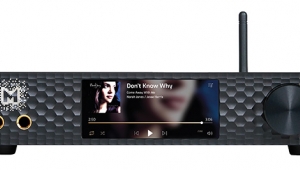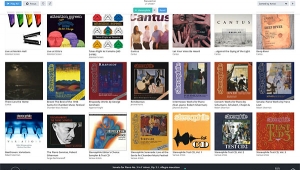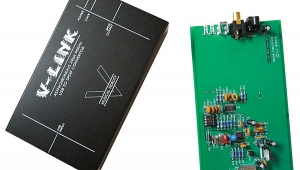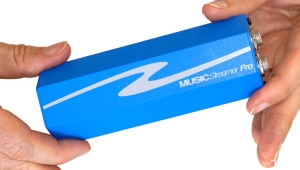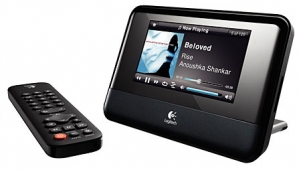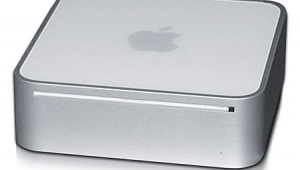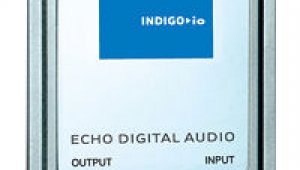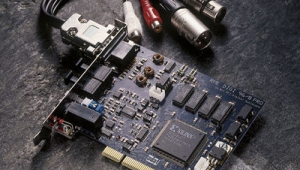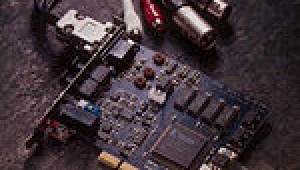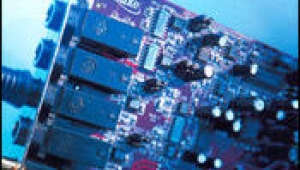| Columns Retired Columns & Blogs |
Digital Audio Labs CardDeluxe PC soundcard Follow-up
Follow-up from Stereophile November 2000, Vol.23 No.9
In my September 2000 review of this high-performance 24-bit/96kHz PCI-bus soundcard (p.70), I described my positive impressions of its analog inputs and outputs. I had used the card's RCA S/PDIF digital input to transfer both CD and 24/88.2/96 music data to my computer's hard drives as WAV files. I also performed almost all my auditioning of the CardDeluxe's S/PDIF data output using it to feed the mighty Mark Levinson No.30.6 D/A processor. However, late in the day I specifically compared the card's analog outputs and an inexpensive Musical Fidelity X-24K processor, which I reviewed in the February 1999 issue of Stereophile.
Something that I did not have time to explore for the September review was the fact that the Musical Fidelity processor wouldn't always lift its mute when driven by the card's data output, even when the unit's Lock LED lit up. This happened only with 44.1kHz-sampled data; 88.2kHz and 96kHz WAV files sounded perfectly normal. Passing the CardDeluxe's output datastream through a reclocking device such as the dCS 972 or Meridian 518 made everything work normally, but this was obviously something that needed investigation.
The first thing I suspected was that, as the computer was also the host for the RME Digi96/8 Pro soundcard that I review elsewhere in this issue, there might be some interference between the two cards' clocks when set to the same sample rate. (Such interference between nonsynchronous clocks set to nominally the same frequency had been a degrading factor with the Apogee PSX-100 reviewed by Michael Fremer last June.) I therefore slaved the RME card to a 96kHz data source while using the CardDeluxe to output 44.1kHz data from its S/PDIF output. Although the Musical Fidelity worked fine in this condition when fed 96kHz and 88.2kHz data by the CardDeluxe, it still performed spasmodically with 44.1kHz data. I used the CardDeluxe's setup utility to set its data output to both Consumer and Professional modes (the latter illuminating the AES/EBU LED on the Levinson's front panel), with no difference in the X-24K's behavior.
The second thing to be investigated was whether there was something wrong with the Musical Fidelity. The X-24K has what appears to be a standard data-receiver circuit based on a Crystal CS8414 chip, and it did lock on to and decode every other 44.1k source I had handy, including the jittery RadioShack CD-3400 portable CD player. However, the other two D/A processors I had to hand—an Assemblage DAC-1, which uses Crystal's older CS8412 data receiver chip, and a PS Audio Ultralink, which uses an obsolete Yamaha chip—successfully worked with the CardDeluxe's 44.1kHz S/PDIF data output. So it's possible that the Musical Fidelity D/A processor was at fault by being exceptionally sensitive to the quality of the 44.1kHz datastream with which it is fed—but, peculiarly, not with datastreams at other sample rates.
In my original review of the CardDeluxe, I noted that while the level of jitter-related artifacts in its analog output while decoding 44.1kHz data was respectably low at 552 picoseconds peak-peak, the noise floor did feature many narrow noise spikes (September, p.75). In this issue's "Manufacturers' Comments," Al Pickard of Digital Audio Labs conjectures that this was due to my slaving the card's S/PDIF input to an external data source, and that using the CardDeluxe to decode a WAV file of the same data on the computer's hard drive would produce better results. However, the graph printed in the magazine was produced from a WAV file with the CardDeluxe set to operate as the master clock. I did use an external CD transport but only to check these results. (The only changes were an increase in the level of the ±229Hz data-related sidebands from 47ps to 118ps and the introduction of a strong pair of jitter sidebands at ±15Hz.)
But checking this measurement reminded me that I had not looked at the effect of jitter on the card's S/PDIF output. I therefore fed the datastream to the X-24K with a 1m length of AudioQuest DigiPro coax and, on one of the occasions when the processor's mute lifted, performed a narrow-band spectral analysis of the processor's analog output using the Miller Audio Research Jitter Analyzer. Source data was the same hard-drive 16-bit, 44.1kHz WAV file—an 11.025kHz tone at -6dBFS overlaid with the LSB toggling at 229Hz—that I had used to test the CardDeluxe's analog outputs in September.
The result can be seen in fig.1 (solid black trace). The absolute jitter level was a moderately high 1199ps peak-peak, while the absolute frequency error was a very low -3ppm. But the analog noise floor is around 12dB higher than I usually see from the Musical Fidelity X-24K on this test. Something is definitely not right with the combination of the X-24K at a 44.1kHz sample rate and the CardDeluxe's digital output, which appears either to have a high level of random noise jitter, a high level of noise on the ground connection, or both.

Fig.1 Musical Fidelity X-24K driven by CardDeluxe via 1m of AudioQuest Digi Pro S/PDIF link, high-resolution jitter spectrum of analog output signal (11.025kHz at -6dBFS with LSB toggled at 229Hz). Center frequency of trace, 11.025kHz; frequency range, ±3.5kHz. Grayed-out trace is via Meridian 518 set to Bypass and 2m of Illuminati S/PDIF cable.
- Log in or register to post comments
